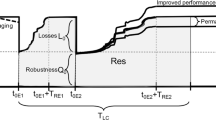Abstract
In this paper, a model able to analyse the seismic behaviour of road network in urban areas, considering interaction between buildings and roads is presented. Damage to buildings and short-term countermeasures, such as propping, can affect roads and even block them, reducing capacity of the road network. Two successive phases are considered. In the first, immediately after the seismic event, emergency services have to reach the relevant buildings. Here, the network topology is of interest. In the second, in the long term, network capacity is not yet completely restored and network demand has to account for displaced people due to unusable buildings. In this case, road serviceability is of interest. In order to consider uncertainties on building behaviour, a probabilistic approach is developed and the network is analysed by means of Monte Carlo simulation. The methodology is applied to the municipality of Potenza (southern Italy) evaluating in the short term, the probability of strategic buildings are not connected and, in the long term, road serviceability.
Similar content being viewed by others
References
Argyroudis, S., Momge, O., Finazzi, D. and Pessina, V. (2003) Vulnerability assessment of lifelines and essential facilities (WP06): methodological handbook – Appendix 1: Roadway transportation system, Risk-UE Final Report, Report n° GTR-RSK 0101-152av7, February.
Franchin P., Lupoi A. and Pinto P.E. (2006) On the role of road network in reducing human losses after earthquakes. Journal of Earthquake Engineering, WSPC Journals 10(2):195–206
Goretti, A. (2004) Interaction between urban system components: road network, buildings, emergency system. XI National Congress on Seismic Engineering, Italy, Genoa, 25–29 January, SGE Editoriali, Padova, Italy (in Italian).
Goretti, A. (2005) A probabilistic model able to handle interaction among road network, buildings and emergency services in urban areas. Proc. IX International Conference On Structural Safety And Reliability, ICOSSAR’05, Rome, 19–23 June.
Grunthal, G. (1998) European Macroseismic Scale 1998, Cahiers du Centre Eur. de Geodyn. et de Seism., v. 15, pp. 1–99.
HAZUS99-SR2 (1997) Technical Manual, Chapter 7 “Direct physical damage to lifelines – transportation systems”, FEMA Distribution Center, Maryland, 97 pp.
Kanafany A. (1983) Transportation Demand Analysis. Mc Graw-Hill, New York
Leestma S. and Nyhoff L. (1993) PASCAL Programming and Problem Solving. Macmillan, USA
Menoni, S., Pergalani, F., Boni, M.P. and Petrini, V. (2002) Lifelines earthquake vulnerability assessment: a systemic approach. Soil Dynamic and Earthquake Engineering, Elsevier Science, Vol. 22, pp. 1199–1208.
SERGISAI (2001) Seismic risk evaluation through integrated use of geographical information systems and artificial intelligence techniques, Project ENV4-0279, Final report, DGXII, EC.
Transportation Research Board (1985) Highway Capacity Manual Washington.
UNIBAS-SSN (2003) Seismic risk evaluation of Potenza urban system. Potenza Project, II Part. Final report (In Italian).
Author information
Authors and Affiliations
Corresponding author
Rights and permissions
About this article
Cite this article
Goretti, A., Sarli, V. Road Network and Damaged Buildings in Urban Areas: Short and Long-term Interaction. Bull Earthquake Eng 4, 159–175 (2006). https://doi.org/10.1007/s10518-006-9004-3
Received:
Accepted:
Published:
Issue Date:
DOI: https://doi.org/10.1007/s10518-006-9004-3




